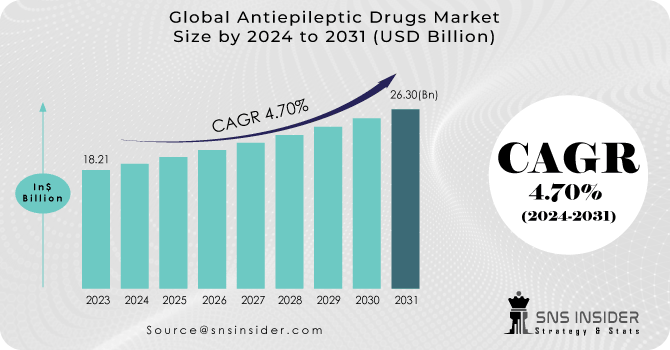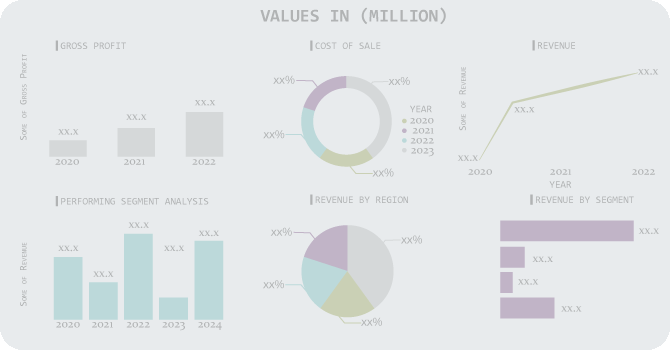Antiepileptic Drugs Market Report Scope & Overview:
The Antiepileptic Drugs Market size was estimated at USD 18.21 billion in 2023 and is expected to reach USD 26.30 billion by 2031 at a CAGR of 4.70% during the forecast period of 2024-2031.
The antiepileptic medication, commonly known as an anti-seizure medication, was created for the asymptomatic and idiopathic treatment of epilepsy and seizures. Antiepileptic medications can also be used to treat neuropathic pain. Therapeutic Drug Monitoring is commonly used to optimise epilepsy therapy. The increasing prevalence of neurological disorders and advancements in medication modification are the primary factors driving market expansion. Furthermore, changing lifestyles, alcoholism, an increasing geriatric population, and active government support and investment will boost total market demand for Antiepileptic Drugs during the projection period of 2022–2030. Antiepileptic medications (AEDs) are anticonvulsants or antiseizure medicines that are used to treat the symptoms of epileptic seizures. Epileptic seizures are characterised by repeated occurrences and are caused by incorrect signals given to the brain by nerve cells. Antiepileptic medications also function as mood stabilisers and are used to treat bipolar disorders and neuropathic pain. The antiepileptics industry has been notably pushed by new medicine approvals in recent years. However, the recent patent expiration of big brands such as Lamictal is projected to stymie market expansion. Some of the prominent players in the worldwide antiepileptic medicine market are GlaxoSmithKline, Johnson & Johnson, Sanofi, Pfizer, Novartis, Abbott, Sunovion Pharmaceuticals, and Cephalon.

To Get More Information on Antiepileptic Drugs Market - Request Sample Report
The First-generation class of antiepileptics, which includes phenytoin, carbamazepine, oxycarbazepine, and valproate, dominates the entire antiepileptics market. Because of their tolerability and effectiveness, the second-generation medicines zonisamide, levetiracetam, and lacosamide are gaining popularity. Geographically, the worldwide antiepileptic medicines market is divided into North America, Europe, Asia-Pacific, and Latin America and the Caribbean (LAMEA). Because of considerable R&D efforts and the existence of authorised second-generation antiepileptics, North America and Europe dominate the worldwide market.
MARKET DYNAMICS
DRIVERS
-
Epilepsy is becoming more common, and the senior population is growing.
-
Drug development advances, as well as increased awareness and diagnosis.
RESTRAIN
-
Side effects and safety concerns with Patent expirations, Regulatory issues.
Drowsiness, dizziness, cognitive impairment, and behavioural changes are all possible side effects of antiepileptic medications. Concerns about the safety of these medications may restrict their use and have an influence on market growth. Several important antiepileptic medications have lost or are about to lose patent protection, resulting in increasing generic competition. For branded pharmaceuticals, this can lead to price erosion and revenue loss. Stringent regulations and approval processes for novel antiepileptic medications might cause pharmaceutical companies to postpone market entry and raise development expenses.
OPPORTUNITY
-
Emerging markets that are yet to be explored Medicine that is tailored to the individual's Technological progress.
CHALLENGES
-
Adherence and compliance issues, generic competition Ineffectiveness and tolerability.
Branded medications may experience pricing challenges and market share erosion when generic copies of antiepileptic treatments become accessible. In the treatment of epilepsy, non-adherence to drug regimens is a serious obstacle. Inadequate seizure control and treatment failure can come from poor compliance. Despite advances, certain individuals may not react well to currently available antiepileptic medicines or may have major side effects, prompting the development of more effective and well-tolerated alternatives.
IMPACT OF RUSSIA-UKRAINE WAR
Healthcare infrastructure is under stress. The war can put a burden on Ukraine's healthcare infrastructure, particularly in conflict-affected areas. The emphasis and resources may be shifted to emergency care and the treatment of war-related injuries, thereby compromising the supply and accessibility of antiepileptic medications. Instability in the economy Both Russia and Ukraine have experienced economic turmoil as a result of the conflict. Individual purchasing power, healthcare budgets, and total healthcare expenditures can all be impacted by this insecurity. It may reduce the price and accessibility of antiepileptic medications, thereby influencing market demand. War and conflict scenarios can contribute to increased stress, trauma, and injuries, which can lead to an increase in the occurrence of epilepsy. This might lead to an increase in the need for antiepileptic medications.
IMPACT OF ONGOING RECESSION
In economic downturns, generic substitution frequently leads to an increased desire for cost-cutting measures. In the case of antiepileptic pharmaceuticals, this may result in a greater demand for generic alternatives rather than branded treatments. Generic replacement may cause branded medicine prices to fall, reducing pharmaceutical firms' income. Recessions may put pressure on healthcare infrastructure as governments and healthcare providers confront financial limitations. This strain may impair the ability to successfully diagnose and treat epilepsy, thereby impacting the prescription and use of antiepileptic medicines.
KEY MARKET SEGMENTATION
By Drug Generation
-
First Generation
-
Second Generation
-
Third Generation
By Distribution Channel
-
Hospital Pharmacies
-
Retail Pharmacies
-
Online Pharmacies
-
Drug Store
Do You Need any Customization Research on Antiepileptic Drugs Market - Enquire Now
REGIONAL COVERAGE
North America
-
US
-
Canada
-
Mexico
Europe
-
Eastern Europe
-
Poland
-
Romania
-
Hungary
-
Turkey
-
Rest of Eastern Europe
-
-
Western Europe
-
Germany
-
France
-
UK
-
Italy
-
Spain
-
Netherlands
-
Switzerland
-
Austria
-
Rest of Western Europe
-
Asia Pacific
-
China
-
India
-
Japan
-
South Korea
-
Vietnam
-
Singapore
-
Australia
-
Rest of Asia Pacific
Middle East & Africa
-
Middle East
-
UAE
-
Egypt
-
Saudi Arabia
-
Qatar
-
Rest of Middle East
-
-
Africa
-
Nigeria
-
South Africa
-
Rest of Africa
-
Latin America
-
Brazil
-
Argentina
-
Colombia
-
Rest of Latin America
REGIONAL ANALYSES
The market for antiepileptic medications is examined in North America, Europe, Asia-Pacific, and Latin America. North America accounted for a significant portion of the epilepsy medications market in 2022 and is likely to retain its dominance throughout the forecast period. The presence of numerous significant companies, such as Novartis AG and Abbott Laboratories, as well as the increasing adoption of epilepsy medications in this area, fuel market expansion.
During the projection period, Asia-Pacific is predicted to grow at the fastest rate. The presence of pharmaceutical businesses in the area, as well as the development of the buying power of populous nations like China and India, are driving market expansion in this region. Furthermore, rising healthcare expenditures and increased knowledge regarding early diagnosis and treatment are driving market expansion in this area. Furthermore, the Asia-Pacific area has the greatest medication supply and the largest pharmaceutical sector, with an abundance of raw materials that producers of antiepileptic drugs may easily acquire. This, in turn, increases the growth expectation for antiepileptic medications.
Key Players
The Major Players are Merck KGaA., Eisai Co., Ltd., AstraZeneca., Novartis AG, Abbott, Teva Pharmaceutical Industries Ltd, Pfizer Inc, GlaxoSmithKline plc, Sanofi, GW Pharmaceuticals Plc, and other players
Eisai Co., Ltd-Company Financial Analysis

RECENT DEVELOPMENTS
Ovid Therapeutics
In January 2022, Ovid Therapeutics teamed with AstraZeneca to get exclusive access to a library of early-stage small molecules that target the KCC2 transporter, including the OV350-leading candidate.
Dr. Reddy Laboratories Ltd.
In January 2020, Dr. Reddy Laboratories Ltd. announced a distribution and co-promotion deal for Briviact in India with UCB S.A. Briviact has been licenced for the treatment of partial-onset seizures in individuals aged 16 and up.
| Report Attributes | Details |
| Market Size in 2023 | US$ 18.21 Bn |
| Market Size by 2031 | US$ 26.30 Bn |
| CAGR | CAGR of 4.70% From 2024 to 2031 |
| Base Year | 2023 |
| Forecast Period | 2024-2031 |
| Historical Data | 2020-2022 |
| Report Scope & Coverage | Market Size, Segments Analysis, Competitive Landscape, Regional Analysis, DROC & SWOT Analysis, Forecast Outlook |
| Key Segments | • By Drug Generation (First Generation, Second Generation, Third Generation) • By Distribution Channel (Hospital Pharmacies, Retail Pharmacies, Online Pharmacies, Drug Store) |
| Regional Analysis/Coverage | North America (US, Canada, Mexico), Europe (Eastern Europe [Poland, Romania, Hungary, Turkey, Rest of Eastern Europe] Western Europe] Germany, France, UK, Italy, Spain, Netherlands, Switzerland, Austria, Rest of Western Europe]). Asia Pacific (China, India, Japan, South Korea, Vietnam, Singapore, Australia, Rest of Asia Pacific), Middle East & Africa (Middle East [UAE, Egypt, Saudi Arabia, Qatar, Rest of Middle East], Africa [Nigeria, South Africa, Rest of Africa], Latin America (Brazil, Argentina, Colombia Rest of Latin America) |
| Company Profiles | Merck KGaA., Eisai Co., Ltd., AstraZeneca., Novartis AG, Abbott, Teva Pharmaceutical Industries Ltd, Pfizer Inc, GlaxoSmithKline plc, Sanofi, GW Pharmaceuticals Plc |
| Key Drivers | • Epilepsy is becoming more common, and the senior population is growing. • Drug development advances, as well as increased awareness and diagnosis. |
| Market Restraints | • Side effects and safety concerns with Patent expirations, Regulatory issues. |

